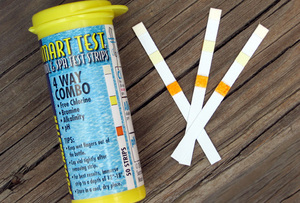The summer swimming season is quickly approaching for backyard pools. Do you know how to test your water quality for safe chemical levels? A quick dip stick style test can help keep your family safe and your pool free from odors or discoloration.
Water testing kits can be purchased from any pool supply store. I prefer to use the combo dip stick products rather than the water sample kits because of convenience of use and how quickly they can give results. A water test should be completed each time before you swim to ensure that the chemical levels are appropriate and won’t cause skin irritation
This season I am using a product called Smart Test Pool & Spa Test Strips (4 way combo). This particular test checks the levels of Free Chlorine, Bromine, Alkalinity and the pH level. When these variables are at their appropriate levels, your pool should be visually and biologically clean and safe to use.
Chlorine & pH Levels
When you maintain proper chlorine levels, algae and bacteria will be killed.Free chlorine is the chlorine that is available to kill bacteria in your pool. Once the chlorine has attacked bacteria in your pool, and combined its molecules with that of the bacteria, you have “combined chlorine” in your pool. Combined chlorine is not able to sanitize your pool because it has already done its job. If your pool has a strong chlorine scent, you have high a high level of combined chlorine. Pool water test kits will test for free chlorine or total chlorine. Total chlorine is simply the combination of free and combined chlorine present in your pool.
Your pH level must be within range for the chlorine to do its job effectively. If your pH level is too high or too low, your chlorine is not able to work effectively. The pH reading on your test kit will tell you how acidic or basic your pool water is at that moment. If you add chlorine to the pool water, your chlorine and pH levels will change. The ideal range for pH is 7.2 to 7.6. The ideal range for free chlorine is 1 to 3 ppm (parts per million).
Bromine.
Bromine, like chlorine, is a disinfecting agent used in pools and spas. Although bromine is more stable at high water temperatures and has less of an odor than chlorine, it is more expensive and can leave a brown stain. If you choose to use bromine to disinfect your pool, the ideal range is 3 to 6ppm.
Alkalinity.
Your test kit will measure how much alkaline substances are in your water. If the amount is too high, your water becomes cloudy and the chlorine isn’t as effective. If your alkalinity is too low, the pool walls and floor can become stained or corroded, your eyes can become irritated while swimming and the water will turn green.
There are several different chemicals available to regulate the Chlorine /Bromine, pH and alkalinity levels in your pool. If your test strips are telling you that you’re out of an acceptable range, your local pool supply store will carry Chlorine Shock, pH Minus & pH Plus, Sodium Bicarbonate and a whole range of other products to regulate your pool.
